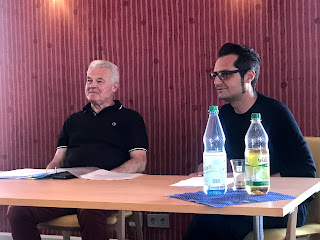Germany with Transatlantic Outreach Program, July 2019
I had always wanted to apply for the TOP program, as many of many adventurous colleagues in other programs had previously gone with TOP to Germany. I applied in the winter of 2019 and a couple of months later found out I would be spending 2 weeks with social studies teacher in Germany in July.
We started in Washington D.C., with an orientation and some cultural lessons at the Goethe Institute, which sponsors TOP, and then flew to Munich, where we started our tour. We traveled from there up to Nuremberg, then to Geisa in the Fulda Gap, and ended in Berlin. It was an immensely important experience for me as a world history teacher. I really should have written more about it, but here were some highlights.
Munich
One of many stops for a drink in the heat of July
The girls school in Nuremberg created cards for us
At the public park in Munich, such a beautiful green space of many acres. I took an evening run through here.
At the former Nazi Rally grounds. This place was sobering to think that thousands once raised their arms in the Nazi salute.
It is a charming city
At the court room where the Nuremberg Trials were held
A walk for international peace
A beautiful cathedral, formerly Catholic, turned Protestant after the Reformation. This had three incredible organs, and I got to hear a bit of an organ recital.
Nuremberg is famous for its spaghetti ice, which is gelato pushed through a sieve, basically. This hazelnut chocolate version had me in a sugar coma for the rest of the day.
Geisa and the Fulda Gap
Looking out from our hotel, which was really a German lord's hunting lodge at one point. It was spectacularly beautiful and hard to imagine that this was one of the most intense spots during the Cold War.
This museum docent lived in East Germany and shared with us a lot of information about the border security. He took us along the old boarder and showed the different layers of security. The watchtower below is original. The dog, as you can probably tell, is fake, but they had layers of mesh fencing, barbed wire, electric fencing, towers, and dogs. I went running one morning not far from here and never saw another human in that hour until right around our hotel. It was eery to realize how different it would have been to not be able to venture out 30 years prior, which from 2019 would have been 1989 and the year I graduated from high school!
Looking at Geisa from a watchtower at Point Alpha, the American camp on the west side, looking east.
On the left was a former officer of the East Germans. He spoke to us about some memories. On the right is one of our guides, Jorge.
We also did a lot of neat cultural activities, like listening to these "horn" players and eat a lot of great German food.
Berlin
The Bundestag house of Parliament for the German Government. Much was destroyed during WWII, and it was repaired and has new wings and a new dome you can walk around (cannot see from this photo).
One of the interesting things we learned here was about all of the Russian writing on the walls of the Bundestag to celebrate capturing it at the end of WWII. It takes some tremendous reckoning with history to keep this (it is now not outside but included on an interior of the building with new parts built around it). I found it really interesting to see how Germany has dealt with their history and have since had this conversation with students.
We went to a center that helps refugees find resources. In 2019, this was close to the years 2015-16 when millions of refugees fled Syria, and many thousands were welcomed (by many) in Germany. We got to meet with some of them and hear their incredible stories. This should be an entire blog post, because it was so impactful to me. We also went on a tour of the area in Berlin where many of these refugees live and work and have many shops and restaurants. My favorite food in the world is Middle Eastern, so it was wonderful to stop here.
We went to a concert of classical music (some of us) in Berlin's historic center. It was incredible.
This is the university and square where Hitler burned thousands of books. Below is The Empty Library at the Bebelplatz (former Opernplatz) in Berlin, designed by Micha Ullman. See the links and to this Wikipedia article: https://en.wikipedia.org/wiki/Nazi_book_burnings
At a portion of the Berlin Wall that serves as a large outdoor museum. The faces on the wall below are of those who lost their lives trying to cross to West Berlin.
Our final dinner with a diplomat of the German Government was at this building.
We also did a lot of business visits to show how Germany is working to combat climate change and implement more sustainable practices. This was a community garden right in the city that we toured.









































No comments:
Post a Comment